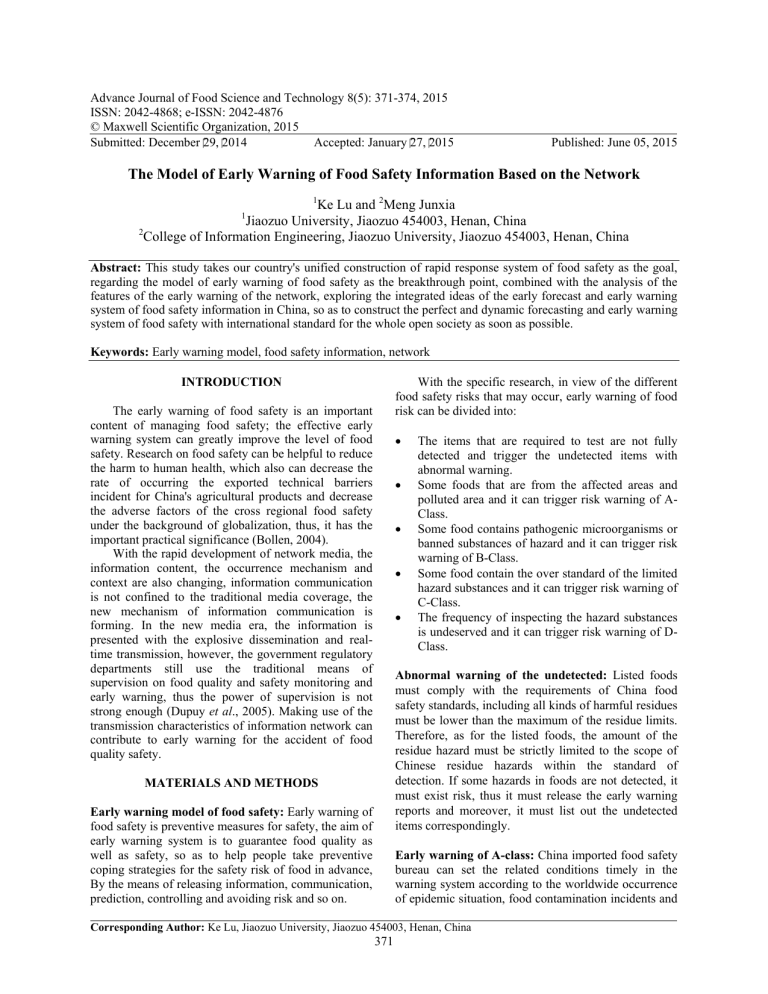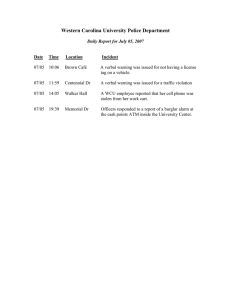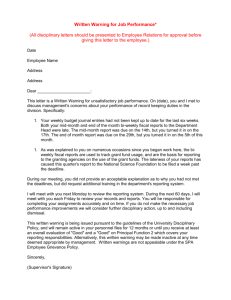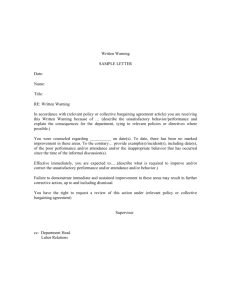Advance Journal of Food Science and Technology 8(5): 371-374, 2015

Advance Journal of Food Science and Technology 8(5): 371-374, 2015
ISSN: 2042-4868; e-ISSN: 2042-4876
© Maxwell Scientific Organization, 2015
Submitted: 29, 2014
Accepted: January
27, 2015
Published: June 05, 2015
The Model of Early Warning of Food Safety Information Based on the Network
1
Ke Lu and
2
Meng Junxia
1
Jiaozuo University, Jiaozuo 454003, Henan, China
2
College of Information Engineering, Jiaozuo University, Jiaozuo 454003, Henan, China
Abstract: This study takes our country's unified construction of rapid response system of food safety as the goal, regarding the model of early warning of food safety as the breakthrough point, combined with the analysis of the features of the early warning of the network, exploring the integrated ideas of the early forecast and early warning system of food safety information in China, so as to construct the perfect and dynamic forecasting and early warning system of food safety with international standard for the whole open society as soon as possible.
Keywords: Early warning model, food safety information, network
INTRODUCTION
The early warning of food safety is an important content of managing food safety; the effective early warning system can greatly improve the level of food safety. Research on food safety can be helpful to reduce the harm to human health, which also can decrease the rate of occurring the exported technical barriers incident for China's agricultural products and decrease the adverse factors of the cross regional food safety under the background of globalization, thus, it has the important practical significance (Bollen, 2004).
With the rapid development of network media, the information content, the occurrence mechanism and context are also changing, information communication is not confined to the traditional media coverage, the new mechanism of information communication is forming. In the new media era, the information is presented with the explosive dissemination and realtime transmission, however, the government regulatory departments still use the traditional means of supervision on food quality and safety monitoring and early warning, thus the power of supervision is not strong enough (Dupuy et al ., 2005). Making use of the transmission characteristics of information network can contribute to early warning for the accident of food quality safety.
MATERIALS AND METHODS
Early warning model of food safety: Early warning of food safety is preventive measures for safety, the aim of early warning system is to guarantee food quality as well as safety, so as to help people take preventive coping strategies for the safety risk of food in advance,
By the means of releasing information, communication, prediction, controlling and avoiding risk and so on.
With the specific research, in view of the different food safety risks that may occur, early warning of food risk can be divided into:
•
The items that are required to test are not fully detected and trigger the undetected items with abnormal warning.
•
Some foods that are from the affected areas and polluted area and it can trigger risk warning of A-
Class.
•
Some food contains pathogenic microorganisms or banned substances of hazard and it can trigger risk warning of B-Class.
•
Some food contain the over standard of the limited hazard substances and it can trigger risk warning of
C-Class.
•
The frequency of inspecting the hazard substances is undeserved and it can trigger risk warning of D-
Class.
Abnormal warning of the undetected: Listed foods must comply with the requirements of China food safety standards, including all kinds of harmful residues must be lower than the maximum of the residue limits.
Therefore, as for the listed foods, the amount of the residue hazard must be strictly limited to the scope of
Chinese residue hazards within the standard of detection. If some hazards in foods are not detected, it must exist risk, thus it must release the early warning reports and moreover, it must list out the undetected items correspondingly.
Early warning of A-class: China imported food safety bureau can set the related conditions timely in the warning system according to the worldwide occurrence of epidemic situation, food contamination incidents and
Corresponding Author: Ke Lu, Jiaozuo University, Jiaozuo 454003, Henan, China
371
Adv. J. Food Sci. Technol., 8(5): 371-374, 2015 other information, this kind of early warning is mainly occurred in the phrase of control the commodity inspection and on-site inspection, as long as it can meet the conditions that are set, without test, it can have further inspection on the relevant hazards and send out warning, at the same time, it can refuse them to enter the domestic market (Shanahan et al ., 2009). relevant information, through monitoring the signs of the network public opinion crisis events, after the occur of the signs, it can carry out the necessary actions so as to resolve and take response measures quickly (Cai,
2005). The relevant departments can be according to the contents of the early warning, by using the comprehensive analysis technology to early find out the
Early warning of B-class: If foods have contained the pathogenic microorganism of banned hazardous substances, namely foods are detected with all kinds of pathogenic bacteria, some foods have residues of the pesticide, veterinary drug and some biological toxins symptoms of the crisis, it can as soon as possible make judgment on the crisis tendency, judging the possible size, so as to be prepared to deal with the crisis.
Generally speaking, according to the monitoring target, even chemical pollutants, once it is detected, it is regarded as positive, it is entered the warning state.
Since the positive is an important threshold for the hazard warning as well as obvious sign, therefore, when the hazard is not detected, the test data itself has not much information available. Thus, the hazard warning will focus on when hazard is positive and how many the detected frequency is in the certain monitoring period.
Early warning of C-class: corresponding warning.
Early warning of D-class:
Early warning of C-Class refers to the risk of the limited hazard, which mainly refers to the hazard of the Maximum Residue Limit
(MRL), the categories can be included pesticide residues, veterinary drug residues, food additives, harmful elements, industrial pollutants and so on.
Maximum residue limits of hazards is the most important index of the threshold of early warning. For each item indicator, the authority management departments will formulate the corresponding international or national standards of China, the standard will specify the Maximum Residue (MRL) of the item, which is the limit standard in the in food safety risk early warning system for the toxic and harmful substances in food, pathogenic microorganisms and other harmful index. When the value of the detection result exceeds the predetermined MRL, it is called as the index of the exceeded hazards; when the result is greater than the detection of the bottom limit, it is called the hazard detection. Therefore, it can issue the
If foods contain a higher risk of hazards, correspondingly, it has higher inspection frequency, while as for those with low degree of risk, correspondingly, it can reduce the inspection frequency. When the actual inspection frequency is deviated from the level of the hazard risk, the system will send a warning of D-Class, which can remind the commodity management personnel to adjust it should set the elements of the items integrated project to enhance the network warning effect, so as to construct the corresponding early warning system.
The main process of network warning is shown as follows.
Making plan: In order to prevent the occurrence of the unexpected events, it can be obeyed the rules.
Therefore, it is very necessary that a good early warning scheme should be made in advance aiming at solving all kinds of unexpected events. According to the different types of the unexpected events, it can make the early warning scheme and grade standard correspondingly.
Paying concern every minute: According to the development trend of network information propagation as well as the similar experience of the trend, as for the occur of the emergency, it should strengthen the monitoring intensity, keep the focus on events at any time, so to master the development and the change of the situation and make response measures timely.
Transmitting and communicating information timely: Establishing and improving the circulation of information mechanism is very important and necessary. When the emergencies occur, it can contact with the relevant departments timely and take emergency plans for the changeable events at any time.
RESULTS AND DISCUSSION
The frame design of the early warning system of food safety: According to the present situation of the food safety management in China, as well as some internationally advanced scientific early warning management mode, we can construct the early warning system framework as Fig. 1, the basic functional modules can be included information source system, early warning analysis system and reaction system, rapid response system.
Information source system: The essence of promptly with the inspection frequency of the hazard.
Early warning of network: Early warning of network refers to the continuous monitoring and measurement on the dynamic network of public opinion, collecting information source system is a database system that can collect the monitoring data; it is the data base for the analysis of early warning system of food safety. The function of the source system is responsible for
372
Adv. J. Food Sci. Technol., 8(5): 371-374, 2015
Fig. 1: The frame of food safety pre-warning system
Fig. 2: Overall flow chart of food safety early warning system collecting, collating, updating and adding the relevant data and information. The input terminal of information source system is the various relevant detected data and information, the output terminal is valid data and information. In order to meet the demand of the data and information for the early warning system of food safety, information source system must be sustained and make reliable protection for data collection and supply, supplementing and updating information and data timely, so as to support information output and processing requirements of the early warning system of food safety fully.
Early warning analysis system: Early warning analysis system is the key and core part of the whole early warning system, its function can directly affect the quality of early warning of the food safety. The input terminal of early warning analysis system is information source system; the output terminal is the analysis of safety crisis information. Generally speaking, warning analysis system includes two parts namely, the index module and the module of analysis model. The index module mainly sets up the evaluation items for food safety crisis, which should be with the typical and scientific characteristic and select the leading indicators that can reflect the food safety situation from the relevant factors. Index data should be provided from information source system. The module of analysis model can be divided into two modules, namely, the subsystem of risk analysis model and
373 subsystem of expert evaluation. The risk analysis model is the theoretical analysis method, which is calculated through data and the limited conditions so as to get the results. Expert evaluation is a special subsystem of the early warning system of food safety.
Early warning analysis system should get food safety testing data and the corresponding index data of food safety firstly, sending them to the warning analysis subsystem; the early warning analysis subsystem can be according to the preset strategy of analysis to analyze the data processing and send the results to the early warning response subsystem; early warning response subsystem can release alarm information to the network of food safety as well as the mobile phone of specific staff, which is the whole work flow of this system, its work process is shown as Fig. 2.
The reaction system: The main function of the reaction system is to make early warning response according to the result and analysis of early warning.
According to the different warning situations, the responding measures are differently divided into the prediction, the forecast, the warning and the adjusting means. The input terminal of the reaction system is warning analysis system, the output terminal is warning controlling instruction (Christophe and Egizio, 2008).
The construction of the reaction system is with big workload, which is also very complicated. The conventional prevention and control of the safety problems can be in charge of by the relevant functional
Adv. J. Food Sci. Technol., 8(5): 371-374, 2015 departments of the nation and enterprises. In particular, only the responsibilities of the producers and managers are clear, plus the rational cooperation of the regulators in time can the reaction system take actions and make reaction timely. support for the Chinese government and departments in charge to deal with food safety crisis, but the sustained improvement of this system need the corresponding laws and regulations as well as the standard, so as to
Rapid response system: The input terminal of the quick response system is the early warning analysis support the construction of the system.
REFERENCES information; the output terminal is the responsive decision and measurement for emergency. Rapid response system increases the coordination command function compared to the general confront system, which puts focus on the prevention and control the rapid developments of the major public health safety.
Rapid response system is a special form of response system, which mainly copes with the emergency as well
Bollen, A.F., 2004. Traceability in fresh produce supply chains. Proceeding of the Postharvest Unlimited
Downunder Conference, 687: 279-288.
Cai, G., 2005. Extending distributed GIS to support geo-collaborative crisis management. Lect. Notes
Comput. Sc., 11: 4-14.
Christophe, C. and V. Egizio, 2008. Coordination for traceability in the food chain: A critical appraisal as the important and unexpected safety events. The key of dealing with the crisis is to capture the opportunities and control it before the occurrence of crisis.
CONCLUSION
Food safety regulation is a complicated systematic project, improving China's food safety forecast and warning information collection, analysis, the release of publication system can provide an important technical of European regulation. Eur. J. Law Econ., 25:
1-15.
Dupuy, C., V. Botta-Genoulaz and A. Guinet, 2005.
Batch dispersion model to optimise traceability in food industry. J. Food Eng., 70: 333-339.
Shanahan, C., B. Kernan, G. Ayalew, K. McDonnell,
F. Butler and S. Ward, 2009. A framework for beef traceability from farm to slaughter using global standards: An Irish perspective. Comput. Electron.
Agr., 66: 62-69.
374




